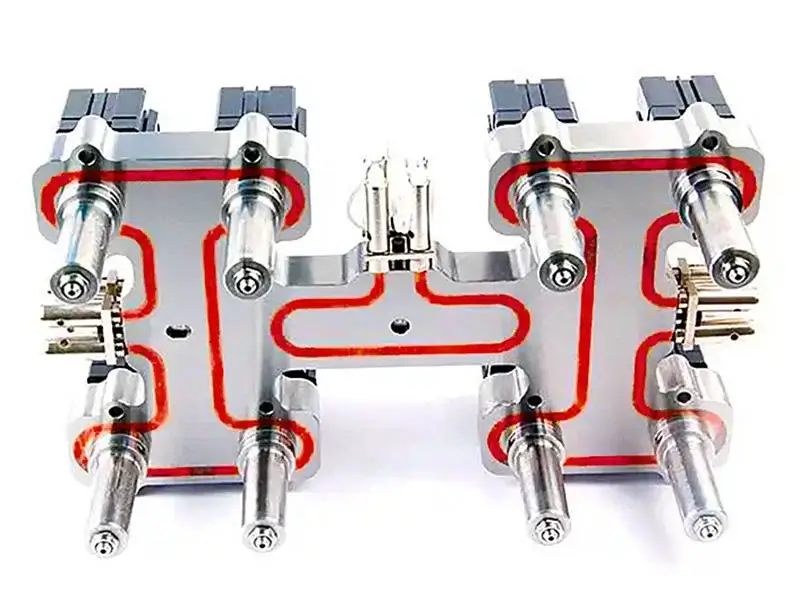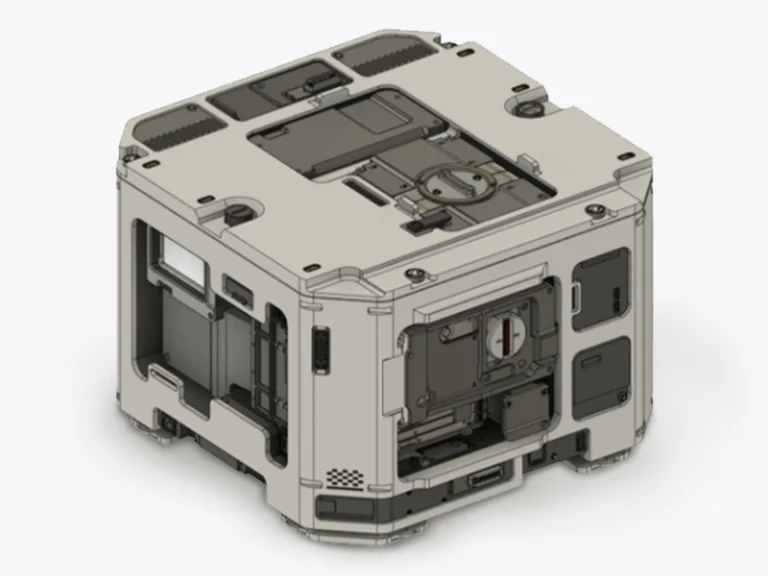Injection pressure in injection molding is a pivotal factor in the process, impacting everything from part quality to production efficiency. Understanding and controlling injection molding pressure is essential for optimizing the injection molding process, reducing defects, and producing high-quality parts efficiently. In this post, we will explore what injection pressure is, injection pressure calculation, and troubleshooting injection pressure issues, etc.
What is Injection Pressure in Injection Molding?
Injection pressure is the force exerted by the reciprocating screw or plunger to push molten plastic resin into the mold cavity. It is typically measured in pounds per square inch (PSI) or megapascals (MPa). This pressure is crucial for overcoming the resistance to the flow of plastic through the nozzle, runners, gates, and mold cavities, ensuring that the mold is filled completely and compactly. Injection pressure is applied during the filling phase of the injection molding cycle and is essential for maintaining the required injection speed and ensuring the quality and consistency of the final product.
The typical injection pressure ranges from 40 to 200 MPa (megapascals), depending on the specific requirements of the molding process and several factors. This range ensures that the mold is filled properly while avoiding excessive pressure that could damage the mold or degrade the plastic material.
Role of Injection Pressure in the Injection Molding Cycle
Injection pressure plays a vital role throughout the injection molding cycle, impacting several key stages and overall part quality:
1. Filling Phase:
Initial Filling: During the initial phase of mold filling, high injection pressure is required to overcome the resistance of the plastic material as it flows through the nozzle, sprue, runners, and gates into the mold cavity.
Complete Filling: Adequate injection pressure ensures that the mold cavity is completely filled with molten plastic, reaching all intricate details and thin sections of the part design. This prevents defects like short shots (incomplete filling) and voids.
2.Pack and Hold Phase:
Packing Pressure: After the mold is initially filled, a lower, sustained pressure, known as packing pressure, is applied. This phase allows additional molten plastic to be packed into the cavity, compensating for material shrinkage as it cools and solidifies.
Holding Pressure: Holding pressure is maintained until the gate solidifies, preventing the backflow of material and ensuring consistent part density and dimensional stability.
3.Cooling Phase:
Pressure Maintenance: Even during the cooling phase, the injection pressure helps in maintaining the part’s shape and preventing defects such as warping or sink marks. Properly controlled pressure ensures that the part retains its intended design as it cools and solidifies.
4.Ejection Phase:
Pressure Release: Once the part is adequately cooled and solidified, the injection pressure is released. The mold then opens, and the part is ejected. Proper control of pressure throughout the cycle ensures that the part can be easily ejected without damage.
What Factors Affecting Injection Pressure in injection molding?
1. Material Properties
Viscosity: The viscosity of the plastic material directly impacts the required injection pressure. High-viscosity materials, such as certain thermoplastics, require higher pressure to flow properly into the mold.
Flow Rate: Materials with different flow characteristics respond differently to pressure. A material with a high flow rate will require less pressure to fill the mold compared to a material with a low flow rate.
2. Mold Design
Cavity Size and Complexity: Larger and more complex mold cavities require higher injection pressures to ensure complete filling. Intricate details and thin-walled sections pose greater resistance to flow.
Number of Cavities: Multi-cavity molds demand higher pressure to fill all cavities evenly and simultaneously. Each additional cavity increases the overall resistance to flow.
Gate Design and Location: The size, shape, and placement of gates affect how easily the molten plastic enters the mold. Poor gate design can lead to increased pressure requirements and potential defects.
Wall Thickness: Thicker walls generally require higher injection pressures to ensure that the material flows adequately and fills the mold without leaving voids or defects.
3. Injection Molding Machine Capabilities
Clamping Force: The injection molding machine’s clamping force must be sufficient to hold the mold halves together under high pressure. Insufficient clamping force can result in mold separation and flash formation.
Screw Design: The design and condition of the injection screw impact the pressure needed to convey and inject the molten plastic. A well-designed screw ensures efficient melting and uniform pressure distribution.
Barrel Temperature: Properly controlled barrel temperature ensures the plastic is melted uniformly, affecting the pressure needed to inject the material into the mold.
4. Injection Molding Process Parameters
Injection Speed: The rate at which the molten plastic is injected into the mold affects the pressure. Higher injection speeds generally require higher pressures to overcome the resistance to flow.
Back Pressure: The pressure applied to the molten plastic in the barrel before injection, known as back pressure, affects the material’s density and temperature, influencing the injection pressure needed.
Cooling Time: The cooling time impacts the solidification of the material in the mold. Proper cooling ensures that the part retains its shape under pressure and minimizes defects like warping and sink marks.
How to Calculate Injection Pressure?
Injection Pressure as a concept is any pressure built up when the screw is pushing plastic forward towards the mold (fill, pack or hold). Injection pressure is the variable that provides some of the most vital information we need to understand and adjust the process as necessary. Injection pressure is determined by a simple equation:
P=F/A
Where:
P=Pressure, This is the result of the force being applied over a specific area. In injection molding, pressure is needed to fill the mold cavity completely and to ensure the material flows correctly.
F=Force, The force exerted by the injection molding machine’s screw. This force pushes the molten plastic into the mold.
A=Area, The cross-sectional area of the mold cavity or the area of the material being injected. This is the area over which the force is distributed.
Troubleshooting Injection Pressure Issues
Injection pressure is a critical parameter in the injection molding process, significantly influencing the quality and consistency of the final product. Improperly calibrated injection pressure will make the molded parts have different issues. There are some common issues related to improper pressure settings
Short Shots:
It occurs when the mold cavity is not completely filled, often due to insufficient injection pressure. This results in incomplete parts that do not meet design specifications.
Flash:
Excessive injection pressure can force the molten plastic out of the mold cavity, creating thin, unwanted layers of plastic on the parting line of the mold. This not only affects the part’s appearance but can also require additional post-processing.
Warping and Dimensional Inaccuracies:
Excessive injection pressure can introduce internal stresses, leading to warping or dimensional inaccuracies as the part cools and solidifies. Balancing pressure with cooling time is important to mitigate these issues.
Jetting:
High injection pressures can cause the molten plastic to enter the mold cavity too quickly, leading to jetting. This defect appears as snake-like lines on the surface of the part and is caused by the material cooling and solidifying too rapidly upon contact with the mold walls.
Material Degradation:
Operating at very high injection pressures can increase shear heat, potentially degrading the material. This can result in discoloration, reduced mechanical properties, and other quality issues.
Increased Wear and Tear on Equipment:
Consistently high injection pressures can accelerate wear and tear on the injection mold and related machinery, increasing the frequency of maintenance and potentially leading to increased production downtime.
Other Types of Pressures in Injection Molding
Except for injection pressure, there are several types of pressures that play critical roles at different stages of the process.
Holding Pressure in Injection Molding
Holding pressure is applied after the mold fills with molten plastic and remains until the gate freezes. It compensates for material shrinkage during cooling, helping maintain the part’s shape and dimensions. Typically, holding pressure is equal to or less than the injection pressure.
Back Pressure in Injection Molding
Back pressure, also known as plasticizing pressure, is the pressure exerted on the head of the screw during the plasticizing stage when the screw retracts to accumulate a new shot of molten plastic. It ensures proper melting and mixing of the material. Back pressure should not exceed 20% of the injection pressure to avoid excessive shear heat and material degradation.
Clamping Pressure in Injection Molding
Clamping pressure is the force applied to keep the mold closed during the injection process, preventing the molten material from leaking out and ensuring the part retains its intended shape. Clamping pressure is calculated based on the projected area of the part and the depth of the mold cavity. It must be sufficient to counteract the injection pressure and keep the mold securely closed during the injection cycle.
Conclusion
Injection pressure is crucial in the injection molding process, directly affecting the quality of the final product. The injection pressure is affected by factors such as injection mold design, injection molding parameters, injection molding machine, and material properties. Understanding and controlling injection pressure is essential for optimizing molding operations and ensuring high-quality parts.
FAQ
What is the ideal injection pressure?
The ideal injection pressure in injection molding varies depending on several factors. Generally, injection pressure ranges from 40 to 200 MPa (megapascals).
What is the difference between injection pressure and injection speed?
Injection pressure is the force exerted by the hydraulic system of the injection molding machine to push molten plastic material through the nozzle into the mold cavity.
Injection speed refers to the rate at which the molten plastic is injected into the mold cavity.
Both parameters are interrelated and must be carefully managed to produce high-quality, consistent parts.




